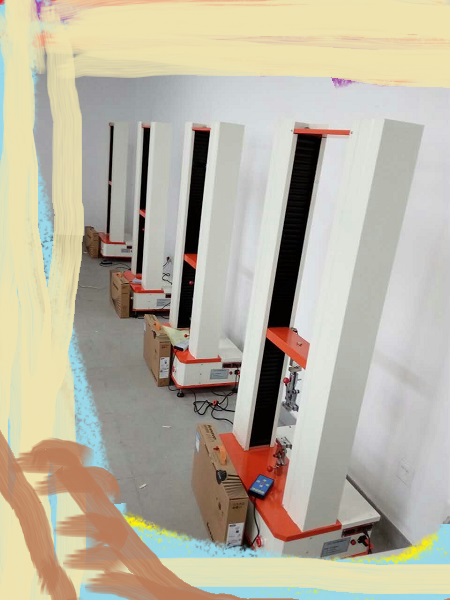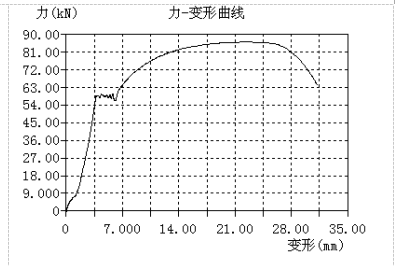雙柱電子拉力試驗(yàn)機(jī)--升*款
軟件說明
a. 軟件系統(tǒng):中英文Windows2000/XP/Win7平臺(tái)下軟件包
b. 自動(dòng)儲(chǔ)存:試驗(yàn)條件、試驗(yàn)結(jié)果��、計(jì)算參數(shù)���、標(biāo)距位置自動(dòng)儲(chǔ)存����。
c. 自動(dòng)返回:試驗(yàn)結(jié)束后�����,試驗(yàn)機(jī)橫梁會(huì)自動(dòng)返回到試驗(yàn)初始位置����。
d. 連續(xù)試驗(yàn):*批試驗(yàn)參數(shù)設(shè)定完成后���,可連續(xù)進(jìn)行測(cè)試。
e. 多種曲線:同*圖形上可顯示多種不同的曲線:荷重--位移��、荷重-時(shí)間���、位移--時(shí)間��、應(yīng)力—應(yīng)變��、荷重—兩點(diǎn)延伸等到多種曲線����。
f. 曲線對(duì)比:同組試樣的曲線可在同*張圖上疊加對(duì)比�。
g. 報(bào)告編輯:可按用戶要求輸出不同的報(bào)告形式。
h. 動(dòng)態(tài)顯示:測(cè)試過程中��,負(fù)荷�、伸長、位移及選中的試驗(yàn)曲線隨著測(cè)試的進(jìn)行���,實(shí)時(shí)動(dòng)態(tài)顯示在主控屏幕上�。
i. 自動(dòng)變標(biāo):試驗(yàn)中負(fù)荷、伸長等曲線坐標(biāo)���,如果選擇不當(dāng)����,可根據(jù)實(shí)測(cè)值的大小�,自動(dòng)變換座標(biāo)。保證在任何情況下 曲線以 大的形式顯示在屏幕上���。
j. 峰值保持:在測(cè)試的整個(gè)過程中,測(cè)試項(xiàng)目的醉大值始終隨著試驗(yàn)的進(jìn)行�����,在屏幕窗口上顯示����。
k. 執(zhí)行標(biāo)準(zhǔn):滿足GB、ISO�、JIS、ASTM���、DIN等多種試驗(yàn)方法和標(biāo)準(zhǔn)����。
雙柱電子拉力試驗(yàn)機(jī)--升*款 軟件功能
軟件基本功能: 能夠測(cè)試材料的彈性模量(E)、上屈服強(qiáng)度��、下屈服強(qiáng)度�����、抗拉強(qiáng)度(Rm)�、規(guī)定塑性延伸強(qiáng)度、規(guī)定總延伸強(qiáng)度�����、規(guī)定殘余延伸強(qiáng)度�、規(guī)定非比例延伸力(Fp0.2)、規(guī)定非比例延伸強(qiáng)度(Rp0.2)�、*大力(Fm)、*大力總延伸(△Lm)����、斷裂總延伸率、能量吸收����、剝離力���、剝離強(qiáng)度等等幾十種參數(shù)。
|
軟件功能
|
描述
|
|
聯(lián)機(jī)/脫機(jī)
|
部分功能在脫機(jī)情況下也可使用
|
|
用戶管理
|
用戶權(quán)限管理���,多用戶管理
|
|
硬件參數(shù)管理
|
1.可編輯主機(jī)參數(shù)和傳感器硬件參數(shù)
2.可管理多個(gè)傳感器信息
|
|
傳感器管理
|
傳感器的方向辨識(shí)����、校準(zhǔn)���、檢定�、切換等等
|
|
執(zhí)行標(biāo)準(zhǔn)管理
|
1.可添加自定義試驗(yàn)標(biāo)準(zhǔn)和試驗(yàn)參數(shù)并導(dǎo)入導(dǎo)出試驗(yàn)標(biāo)準(zhǔn)
2.支持GB�、GB/T����、BS、ASTM����、ISO等多種標(biāo)準(zhǔn)
|
|
試驗(yàn)方案
|
1.編輯好的試驗(yàn)方案可導(dǎo)入到其他試驗(yàn)機(jī)上使用
2.通過編輯運(yùn)行方案,可實(shí)現(xiàn)力控�����、位移控、變形控等多種控制方式組合運(yùn)行�,從而滿足任何試驗(yàn)運(yùn)行需要
|
|
曲線顯示
|
1.單圖顯示:顯示力-時(shí)間,變形-時(shí)間��,位移-時(shí)間�����、應(yīng)力-時(shí)間����、應(yīng)變-時(shí)間、力-變形�����、力-位移����、應(yīng)力-應(yīng)變等中的任意需要的*組曲線
2.多圖顯示:顯示力-時(shí)間,變形-時(shí)間��,位移-時(shí)間����、應(yīng)力-時(shí)間�����、應(yīng)變-時(shí)間����、力-變形�、力-位移、應(yīng)力-應(yīng)變等中的任意需要的三組曲線�,便于對(duì)比分析。
|
|
試驗(yàn)結(jié)果及曲線分析
|
1.曲線坐標(biāo)預(yù)設(shè)或在線設(shè)置��;曲線平移����、縮放
2.試驗(yàn)數(shù)據(jù)可通過曲線遍歷和曲線回放查看
3.可在曲線上顯示、修改于保存結(jié)果點(diǎn)
|
|
試驗(yàn)報(bào)告
|
支持Word和Excel格式報(bào)告輸出���。有定制、預(yù)覽��、輸出/導(dǎo)出等功能
|
|
試驗(yàn)數(shù)據(jù)管理
|
1.可查詢�、刪除、保存試驗(yàn)數(shù)據(jù)
2.可繼續(xù)未完成的批量試驗(yàn)
|
|
與手控器關(guān)系
|
手控器功能與軟件運(yùn)動(dòng)控件功能對(duì)應(yīng)相同
|
|
加密
|
通過加密工具可以設(shè)置控制器的使用期限
|
|
單位參數(shù)
|
可根據(jù)需要增加各種單位
|
|
修約方式
|
可根據(jù)標(biāo)準(zhǔn)要求對(duì)結(jié)果項(xiàng)進(jìn)行各種修約
|
常見故障:
1:上升、下降�����、試驗(yàn)操作時(shí)���,按下鍵后顯示停止
解決方案:1:檢查系統(tǒng)設(shè)置當(dāng)前量程設(shè)置和過載保護(hù)率
2:檢查速度參數(shù)是否變化
3:檢查傳感器是否過載
2:上電后儀表藍(lán)屏
解決方案: 1:重新上電
2:重新上電如果不行���,拿到?jīng)]有干擾的地方上電試*下
3:聯(lián)系生產(chǎn)廠***更換液晶屏
3:橫梁不移動(dòng)
解決方案:1:檢查數(shù)據(jù)線是否連接號(hào)
2:檢查是否過載,傳感器是否損壞
3:是否限位��,移動(dòng)磁鐵
4:儀表不準(zhǔn)確
解決方案: 1:傳感器是否損壞
2:調(diào)整了標(biāo)定系數(shù)
3:是否年檢
試驗(yàn)機(jī)儀表:
本儀表采用***際比較*進(jìn)的放大器�����,A/D����、微處理器、高性能高清晰的液晶顯示屏構(gòu)成���,整個(gè)系統(tǒng)采用類似手機(jī)PDA鍵盤��,光標(biāo)導(dǎo)航�,全中文顯示,浮點(diǎn)數(shù)數(shù)據(jù)處理���,結(jié)構(gòu)簡單操作方便�����,自動(dòng)計(jì)算存儲(chǔ)�,適合于企業(yè)��,質(zhì)檢單位材料力學(xué)性能檢測(cè)儀表���。
注意事項(xiàng):
1初次開機(jī)前�,請(qǐng)檢查各種連線的準(zhǔn)確性以及輸入電源的正確性�����,電源*定為交流220V交流電源��,接地良好����。
2試驗(yàn)前��,請(qǐng)正確設(shè)置試驗(yàn)參數(shù),以保證試驗(yàn)數(shù)據(jù)的準(zhǔn)確性��。
試驗(yàn)
1��、 **使用“上升”和“下降”調(diào)整中橫梁的位置來夾取試樣(試樣夾上之后�����,不能太緊����,不能帶力)
2、 按*下“力清零”鍵�����,把力清掉��,按下“試驗(yàn)”鍵開始做試驗(yàn)����,直到試樣被破壞,設(shè)備自動(dòng)停機(jī)�,出現(xiàn)數(shù)據(jù)。
3���、 如果試樣已破壞�����,設(shè)備沒有自動(dòng)停機(jī)���,則手動(dòng)按下“停止”然后���,進(jìn)入“系統(tǒng)設(shè)置”更改*下“破型判斷”和“破型起限”的值,已達(dá)到自動(dòng)停機(jī)的目的����。
4、 試驗(yàn)完成�,關(guān)閉電源,打掃衛(wèi)生�。
工作環(huán)境條件
1 在室溫100C~350C范圍內(nèi),相對(duì)濕度不大于80%�����;
2 在穩(wěn)固的基礎(chǔ)或工作臺(tái)上正確安裝�����,水平度為0.2/1000;
3 在無震動(dòng)�、無腐蝕性介質(zhì)和無較強(qiáng)電磁場(chǎng)干擾的環(huán)境中�����;
4 電源電壓的波動(dòng)范圍不應(yīng)超出額定電壓的±10%�����。
注意事項(xiàng):
1初次開機(jī)前��,請(qǐng)檢查各種連線的準(zhǔn)確性以及輸入電源的正確性����,電源*定為交流220V交流電源,接地良好��。
2試驗(yàn)前���,請(qǐng)正確設(shè)置試驗(yàn)參數(shù)�����,以保證試驗(yàn)數(shù)據(jù)的準(zhǔn)確性��。
菜單設(shè)置
按‘設(shè)置’鍵進(jìn)入選擇界面界面顯示‘系統(tǒng)設(shè)置’‘數(shù)據(jù)’���。
系統(tǒng)設(shè)置:包括‘試驗(yàn)方法’‘返回設(shè)置’‘預(yù)緊力’‘破型判斷’‘破型起限’‘高速設(shè)置’‘速度參數(shù)’‘*大量程’‘過載保護(hù)率’
試驗(yàn)方法: 進(jìn)入界面后光標(biāo)在此行閃爍�,按數(shù)字鍵‘1’�����,‘2’進(jìn)行試驗(yàn)方法的選擇
返回設(shè)置:返回速度的設(shè)置1-500mm/min任意速度輸入
預(yù) 緊 力:表示當(dāng)前力值大于或等于設(shè)定值時(shí)位移自動(dòng)清零��,此值任意設(shè)置
破型判斷:表示當(dāng)前試驗(yàn)力值下降大于設(shè)定力值時(shí)��,試驗(yàn)機(jī)自動(dòng)停機(jī)��。
破型起限:表示當(dāng)前試驗(yàn)力大于此設(shè)定值時(shí)��,破型判斷有效��,破型判斷破型起限���,根據(jù)實(shí)際情況設(shè)置
高速設(shè)置:系統(tǒng)當(dāng)前可以切換的*高速度值
中速設(shè)置:系統(tǒng)當(dāng)前默認(rèn)值�����,試驗(yàn)時(shí)��,橫梁移動(dòng)時(shí)系統(tǒng)自動(dòng)默認(rèn)值
低速設(shè)置:系統(tǒng)當(dāng)前可以切換的*低速度值
速度參數(shù):系統(tǒng)調(diào)速的控制參數(shù)出場(chǎng)時(shí)調(diào)整���,用戶不能隨意更改
*大量程:當(dāng)前儀器的*大量程���,根據(jù)傳感器的大小而定����,用戶不能隨意更改。
過載保護(hù):當(dāng)前儀器的過載保護(hù)率用戶��,不可隨意更改
試驗(yàn)方法選擇
進(jìn)入系統(tǒng)設(shè)置后按數(shù)字鍵(1,2)選擇試驗(yàn)方法1選擇(抗拉強(qiáng)度)2(彎曲)完成后移動(dòng)光標(biāo)選擇可以修改光標(biāo)指定的各數(shù)據(jù)項(xiàng)����,返回主界面后不同的試驗(yàn)方法有不同的試驗(yàn)界面,用戶可根據(jù)自己的試驗(yàn)方法進(jìn)行選擇使用�,橫向斷裂強(qiáng)度數(shù)據(jù)如果感覺精度不夠時(shí)用戶可以利用峰值自己進(jìn)行運(yùn)算。
注:(由于資源有限計(jì)算結(jié)果僅供參考)裂界面
維護(hù)與保養(yǎng)
1軸承內(nèi)的潤滑脂*般3—5年更換*次��。
2 試驗(yàn)機(jī)應(yīng)每年請(qǐng)當(dāng)?shù)赜?jì)量部門檢定*次���。
基本參數(shù)部分
試驗(yàn)方案名:也就是*個(gè)試驗(yàn)方案的代號(hào)�����。試驗(yàn)方案名是*個(gè)試驗(yàn)方案的唯*標(biāo)識(shí)���,請(qǐng)你取名時(shí)注意根據(jù)不同試驗(yàn)的不同要求來命名����,如金屬拉伸試驗(yàn)�����,你用引伸計(jì)做��,試樣是棒材�,你可以命名試驗(yàn)方案為"金屬拉伸_引伸計(jì)_棒材",從而以示與用位移測(cè)量變形與其它試樣形狀的區(qū)別�。試驗(yàn)方案命名請(qǐng)遵循微軟Windows文件命名規(guī)范。建議使用全角方式的字符���,半角方式的特殊字符*好不要使用
試驗(yàn)方向:通?�?梢赃@么說的�,就是加載的方向��,做拉向的試驗(yàn)就選擇拉向,做壓向試驗(yàn)就選擇壓向��。需要在壓的空間做試驗(yàn)�����,試驗(yàn)方案就要設(shè)置壓向���,需要在拉的空間做試驗(yàn)���,試驗(yàn)方案就要設(shè)置為拉向��。
變形計(jì)算選擇:根據(jù)試驗(yàn)要求選擇位移���、變形�、擴(kuò)展設(shè)備����。
試樣材料形狀:試樣的形狀。(這里有六種形狀提供選擇:①棒材�,試樣尺寸輸入試樣直徑;②板材����,試樣尺寸輸入試樣寬度和試樣厚度�;③管材�����,試樣尺寸輸入試樣外徑和試樣壁厚�����;④異型�,試樣尺寸直接輸入原始橫截面積;⑤忽略���,所有結(jié)果值與試驗(yàn)原始橫截面積無關(guān)�。)
自動(dòng)返回:試驗(yàn)運(yùn)行結(jié)束自動(dòng)恢復(fù)到初始的受力零點(diǎn)����。
預(yù)加載力:就是試驗(yàn)力達(dá)到這個(gè)設(shè)置力,軟件才開始保存采樣的數(shù)據(jù)���,也就是到這個(gè)時(shí)刻開始����,采樣數(shù)據(jù)才有效。這*項(xiàng)目的是為了消除夾具�、試驗(yàn)等連接部分的間隙而設(shè)置,*般可以設(shè)置為建議值(為當(dāng)前力傳感器滿量程的5/10000)���。達(dá)到預(yù)加載力的這個(gè)時(shí)刻軟件對(duì)變形傳感器進(jìn)行自動(dòng)清零�����。
過濾點(diǎn)數(shù):就是去除掉試驗(yàn)過程中所有采樣點(diǎn)中*后面的點(diǎn)數(shù)���。試驗(yàn)結(jié)束時(shí),由于機(jī)器采樣速度很快����,比如會(huì)把試樣斷裂時(shí)的無用的數(shù)據(jù)也采到了�����,故在此去除*后面的*些點(diǎn)數(shù)�,以免影響斷裂力的求取或曲線的美觀。*般32(這個(gè)也是經(jīng)驗(yàn)值)就可以了����。如果試驗(yàn)方案中是多步試驗(yàn)�����,*后那*步是保載過程���,并且選擇了間隔采樣的話,強(qiáng)烈建議【去除點(diǎn)數(shù)】設(shè)置為0即可��。
定負(fù)荷:是*個(gè)重要的試驗(yàn)停止條件�,就是試驗(yàn)在過程中試驗(yàn)力達(dá)到這個(gè)定力(單位為:N)時(shí)候,試驗(yàn)就自動(dòng)結(jié)束���。比如你做某個(gè)試驗(yàn)�,需要在試樣受力達(dá)到1000N,就停止試驗(yàn)�,你這里就可以設(shè)置為1000即可。這個(gè)停止條件在其他時(shí)候還可以有效保護(hù)力傳感器��,比如這臺(tái)試驗(yàn)機(jī)當(dāng)前力傳感器的*大量為10kN�,我們做試驗(yàn)過程不允許試驗(yàn)力超過10kN,如果我們?cè)谶@里定力停止條件設(shè)置為10000N���,也就是當(dāng)前力傳感器的滿量程�����,這樣在試驗(yàn)過程中試驗(yàn)力*達(dá)到10000N就會(huì)自動(dòng)停止試驗(yàn)����,這樣就可以保護(hù)力傳感器。
定變形:這也是*個(gè)試驗(yàn)停止條件�,這里的定變形是指用引伸計(jì)測(cè)量的變形值達(dá)到這個(gè)定變形值,試驗(yàn)就會(huì)自動(dòng)停止�����。用戶可以參考定力的用法使用這個(gè)停止條件���。這個(gè)停止條件只有變形傳感器選擇引伸計(jì)時(shí)候才有用的��,*般用得很少����。
定位移:這也是*個(gè)試驗(yàn)停止條件�,就是指當(dāng)位移測(cè)量的變形達(dá)到這個(gè)定位移值�����,試驗(yàn)就會(huì)自動(dòng)停止�。用戶可以參考定力的用法使用這個(gè)停止條件���。
售后服務(wù)
*、安裝調(diào)試:協(xié)助試驗(yàn)機(jī)的安裝�,負(fù)責(zé)試驗(yàn)機(jī)的運(yùn)輸、調(diào)試����。
二、驗(yàn)收標(biāo)準(zhǔn):試驗(yàn)機(jī)按訂貨技術(shù)附件進(jìn)行驗(yàn)收�����。終驗(yàn)收在買方進(jìn)行�����,對(duì)用戶提供的試樣進(jìn)行試驗(yàn)����,并提供測(cè)試報(bào)告。
三���、培訓(xùn):安裝調(diào)試同時(shí)��,在儀器操作現(xiàn)場(chǎng)*次性免費(fèi)培訓(xùn)操作人員2-3名����,該操作人員應(yīng)是由需方選派的長期穩(wěn)定的員工,培訓(xùn)后能夠?qū)υO(shè)備基本原理�����、軟件使用�、操作、維護(hù)事項(xiàng)理解和應(yīng)用���,使人員能夠獨(dú)立操作設(shè)備對(duì)樣品進(jìn)行檢測(cè)�����、分析����,同時(shí)能進(jìn)行基本的維護(hù)�����。
四�����、軟件升*:終生免費(fèi)提供新版本控制軟件����。
Basic parameters section
Experimental Plan Name: This is the code name of an experimental plan. The name of the test plan is the unique identifier of a test plan. When naming, please pay attention to naming according to the different requirements of different tests. For example, in the me-tal tensile test, if you use an extensometer to do it, and the sample is a bar, you can name the test plan "me-tal Stretching Stretching Elongation Meter Bar" to show the difference between measuring deformation with displacement and other sample shapes. Please follow the Microsoft Windows file naming convention when naming the experimental plan. It is recommended to use characters in full width mode, and special characters in half width mode should not be used
Test direction: It can usually be said that the direction of loading is chosen for tensile tests and compressive tests. The experiment needs to be conducted in a compressed space, and the experimental plan needs to be set in a compressed direction. The experiment needs to be conducted in a tensioned space, and the experimental plan needs to be set in a tensioned direction.
Selection of deformation calculation: selec displacement, deformation, and expansion equipment according to experimental requirements.
Sample material shape: The shape of the sample. (There are six shapes to choose from: ① bar, sample size input sample diameter; ② plate, sample size input sample width and thickness; ③ pipe, sample size input sample outer diameter and sample wall thickness; ④ irregular, sample size input original cross-sectional area directly; ⑤ ignored, all result values are independent of the original cross-sectional area of the test.)
Automatic return: After the test run is completed, it automatically returns to the initial force zero point.
Pre loading force: It means that the software only starts saving the sampled data when the experimental force reaches this set force, which means that the sampled data is only valid from this moment on. This project is designed to eliminate gaps in connecting parts such as fixtures and tests, and can generally be set to the recommended value (5/10000 of the current force sensor's full range). At the moment when the preloading force is reached, the software automatically zeros the deformation sensor.
Filter point count: It means removing the last point count from all sampling points during the experimental process. At the end of the experiment, due to the fast sampling speed of the machine, such as collecting useless data when the sample fractures, the last few points are removed here to avoid affecting the calculation of fracture force or the appearance of the curve. Usually 32 (which is also an experience value) is sufficient. If the experimental plan involves multi-step testing, and the last step is the load holding process, and interval sampling is selected, it is strongly recommended to set the [number of removed points] to 0.
Fixed load: It is an imp0rtant test stopping condition, which means that the test will automatically end when the test force reaches this fixed force (unit: N) during the process. For example, if you are conducting a certain experiment and need to stop the test when the force on the sample reaches 1000N, you can set it to 1000 here. This stopping condition can also effectively protect the force sensor at other times. For example, the maximum current force sensor of this testing machine is 10kN, and we do not allow the test force to exceed 10kN during the testing process. If we set the stopping condition to 10000N, which is the full range of the current force sensor, the test will automatically stop as soon as the test force reaches 10000N during the testing process, which can protect the force sensor.
Fixed deformation: This is also a stopping condition for the experiment, where the fixed deformation refers to the deformation value measured with an extensometer reaching this fixed deformation value, and the experiment will automatically stop. Users can refer to the usage of Dingli to use this stop condition. This stopping condition is only useful when selecting an extensometer for deformation sensors, and is generally rarely used.
Positioning displacement: This is also a stopping condition for the experiment, which means that when the deformation measured by displacement reaches this positioning displacement value, the experiment will automatically stop. Users can refer to the usage of Dingli to use this stop condition.
after-sale service
1、 Installation and debugging: Assist in the installation of the testing machine, responsible for the transportation and debugging of the testing machine.
2�����、 Acceptance criteria: The testing machine shall be accepted according to the ordered technical attachments. The final acceptance shall be carried out by the buyer, who shall conduct tests on the samples provided by the user and provide test reports.
3����、 Training: During installation and debugging, 2-3 operators will be trained free of charge at the instrument operation site at once. These operators should be long-term and stable employees selected by the demand side. After the training, they should be able to understand and apply the basic principles, software usage, operation, and maintenance of the equipment, so that they can independently operate the equipment to test and analyze samples, and perform basic maintenance.
4、 Software upgrade: New version control software is provided for free for life.

